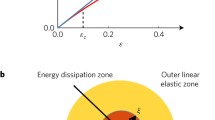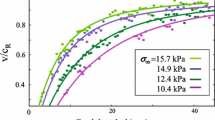Abstract
The optical recording of the conditions at the tips of dynamically moving cracks is often associated with a wave pattern which arises from what we call here “radial waves”. This observation is prevalent for tough solids, especially when the observation tools involve surface deformations such as the caustic method. These waves can modify the caustic shape and size and thus influence the interpretation of measurements. The quantification of the sources of these waves poses a very difficult problem so that a precise evaluation of that phenomenon is not yet possible. However, in an attempt to better understand the limitation imposed on the method of caustics by this set of waves this paper analyzes primarily the change of shape in the caustic associated with the passage of “radial waves” over the region of the initial curve of the caustic. The analysis is approximate in that the “radial waves” are assumed to be insensitive to the presence of the crack surfaces, but otherwise accounts for the three dimensional character of wave propagation in a plate of finite thickness.
Résumé
On associe souvent l'enregistrement optique des conditions présentes à l'extrémité de fissures en cours de propagation spectaculaire, à une disposition ondulée, due à ce que l'on dénomme ici des “ondes radiales”. L'observation vaut surtout pour les corps à haute ténacité, et en particulier lorsque les méthodes d'observation tiennent compte des déformations de surface, comme la méthode des caustiques. Les ondes radiales peuvent altérer la forme et la dimension d'une caustique, et, de ce fait, influencer l'interprétation des mesures. Une évaluation précise de ce phénomène n'est pas encore possible, car la quantification des sources de ces ondes pose un problème trés délicat. Néanmoins, en vue de mieux comprendre les limites qu'impose à la méthode des caustiques la formation de ces ondes, on a analysé essentiellement le changement de forme de la caustique lorsque se développent des “ondes radiales” sur la région couverte par la courbe originale de la caustique. On procède à une approximation dans la mesure où on suppose que les “ondes radiales” sont insensibles à la présence des surfaces de la fissure, mais prennent par ailleurs en considération le caractère tridimensionnel de la propagation d'une fissure dans une plaque d'épaisseur finie.
Similar content being viewed by others
References
K.Ravi-Chandar and W.G.Knauss, Journal of Applied Mechanics 54 (1987) 72–78.
W.G.Knauss, Engineering Fracture Mechanics 23 (1986) 9–20.
K.S.Kim, Journal of Applied Mechanics 52 (1985) 291–297.
W.G.Knauss and K.Ravi-Chandar, International Journal of Fracture 27 (1985) 127–143.
L.B.Freund, Journal of Mechanics and Physics of Solids 20 (1972) 129–140.
N.Vasudevan and A.K.Mal, Journal of Applied Mechanics 52 (1985) 356–362.
P. Manogg, “Anwendungen der Schattenoptik zur Untersuchung des Zerreißvorgangs von Platten,” Ph.D. disseration, University of Freiburg (1984).
P.S.Theocaris and E.E.Gdoutos, Journal of Applied Mechanics 39 (1972) 91–97.
A.J. Rosakis and A.T. Zehnder, “On the Method of Caustics: An exact Analysis based on Geometrical Optics,” GALCIT SM Report 84–1, California Institute of Technology, Pasadena.
J.F. Kalthoff, J. Beinert and S. Winkler, in I.U.T.A.M. Symposium on Optical Proceedings Methods in Mechanics of Solids, Poitiers, France (1979) 497–507.
A.J. Rosakis, L.B. Freund and J. Duffy, “Determination of the Fracture Initiation and Crack Propagation Resistance of Structural Steels by the Optical Method of Caustics,” Brown University Report MRL E-142, Materials Research Labs, Brown University (1982).
K. Ravi-Chandar, “An Experimental Investigation into the Mechanics of Dynamic Fracture,” Ph.D. thesis, California Institute of Technology, Pasadena, California (1982).
I. Wolock and S.B. Newman, in Fracture Processes in Polymeric Solids, Phenomena and Theory, Bernard Rosen (ed.), Interscience Publishers (1964) 235–290.
Author information
Authors and Affiliations
Rights and permissions
About this article
Cite this article
Vasudevan, N., Knauss, W.G. An approximate analysis of the effect of micro fractures on the caustic of a dynamically moving crack tip. Int J Fract 36, 121–135 (1988). https://doi.org/10.1007/BF00017791
Received:
Accepted:
Issue Date:
DOI: https://doi.org/10.1007/BF00017791




